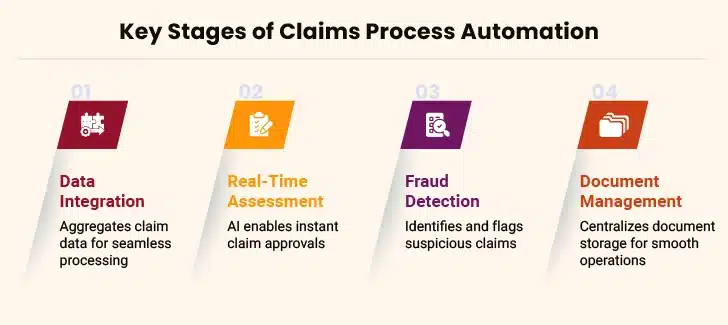Providing elevated customer experiences to policyholders has become a necessity for insurers in order to survive the competition. Claims processing is one area where insurance businesses can gain a substantial edge. Traditional, manual claims processes can be slow, inaccurate, and unreliable, resulting in frustrated policyholders and insurers.
As more and more insurance businesses are digitizing business activities, claims automation is a no-brainer as it reduces the turnaround time of getting claims processed and lowers the cost-to-serve. This transformative approach harnesses the capabilities of advanced insurance claims software to optimize the claims process..
In this blog, we’ll explore the advantages of claims automation and how it can become a customer-centric advantage for your insurance business. But, before delving into the benefits of claims automation, it’s essential to understand the challenges associated with manual claims processing.
Table of Contents
Challenges of Manual Claims Processing
The Importance of Customer Centricity in Insurance Claims
What is Claims Process Automation?
How Does Claims Process Automation Work?
Top Five Technologies Transforming Claims Processing Automation
- 1. Artificial Intelligence (AI) and Machine Learning (ML)
- 2. Robotic Process Automation (RPA)
- 3. Optical Character Recognition (OCR)
- 4. Blockchain Technology
- 5. Internet of Things (IoT)
How Does Claims Automation Enhance Customer-Centricity?
Conclusion
Case in Focus
Challenges of Manual Claims Processing
- Slow Claims Resolutions
Manual and partial digitized claims processing is time-consuming. It consists of various steps, from gathering documents to verifying the details, which might result in delayed resolution payouts. - Inaccuracies
Manual processes are more error-prone. If the majority of data entry and assessment is done manually, then it may open the doors to litigation or financial penalties. - Inefficiencies
Manual claims processing is tedious and contributes to low productivity. It often results in higher operational costs and causes dissatisfaction among employees. - Customer Frustration
Modern customers today expect quick and hassle-free claims settlements. Long and complicated procedures might cause frustration and a lack of trust.
The Importance of Customer Centricity in Insurance Claims
1. Builds Trust with Customers
Customer-centricity in claims builds trust. Since insurance is a promise, when policyholders file a claim, they expect help. A smooth, transparent process reassures them, while delays and confusion reduce confidence. Fast, fair settlements show reliability and enhance customer trust, which leads to loyalty. Satisfied policyholders renew policies and recommend the company to their peers.
2. Improves Customer Retention
A positive claims experience increases retention. Delays in claims processing can cause policyholders to switch providers. Also, a seamless process shows commitment. Retained customers mean steady revenue, as it costs less to retain customers than to find new ones.
3. Reduces Disputes and Complaints
Clear communication prevents misunderstandings, and a customer-first approach avoids disputes. Thorough explanation of coverage reduces frustration, and a fair process minimizes complaints. Fewer complaints mean better efficiency. Also, resolving issues quickly improves satisfaction.
4. Increases Efficiency in Claims Processing
Focusing on customer needs speeds up processing. Quick claims handling reduces paperwork, and digital tools help streamline approvals. A structured process avoids delays, leading to more satisfied policyholders. As such, efficiency benefits policyholders and insurers.
5. Aligns with Regulatory Expectations
A customer-first approach helps insurers meet compliance standards and focus on fair treatment. Transparent claims processing facilitated by modern claims automation in insurance helps insurers avoid penalties. Such ethical business practices build credibility, ensuring long-term business success.
6. Helps Differentiate from Competitors
Many insurers offer similar policies. In such cases, customer service emerges as the differentiating factor. A focus on claims experience helps insurers stand out. Policyholders choose companies that prioritize them and make them feel valued. As such, customer-focused service creates a competitive edge.
What is Claims Process Automation?
Insurance claim process automation is the application of technology to quickly and accurately process insurance claims. It minimizes manual labor through artificial intelligence, robotic process automation, and other digital technologies.
Automation assists insurers in verifying claims, identifying fraud, and approving payments more quickly. It enhances efficiency by eliminating paperwork and human mistakes. Customers enjoy quicker settlement of claims and improved service. Computer systems scan claim information, verify policy information, and uphold regulation compliance.
Automating insurance claims saves time and money for companies. Insurance claim process automation results in smoother claims handling and increased customer satisfaction.
How Does Claims Process Automation Work?
Automated claims processing can help insurers overcome various challenges and improve customer experience. Here is how claims automation works:
I. Faster Data Integration and Capture
Claims automation begins with integrating data from different sources, such as policy documentation, medical reports, and third-party databases. It helps ensure that all the relevant data is available at the fingertips.
II. Real-time Assessment
Auto claims management software solutions leverage Artificial Intelligence and Machine Learning algorithms for assessing claims in real time. This enables instant approval of simple claims and shortens the processing time.
III. Accurate Fraud Detection
Automated claims systems include fraud detection capabilities that assess past data and flag potentially fraudulent claims for further review. As a result, insurance businesses can reduce fraudulent payouts and streamline investigations.
IV. Efficient Document Management
Automated claims processing software solutions can capture and save documents from several sources. This enables a single source of truth and improves communication across systems and departments.
V. Enhanced Customer Experience
Quick and accurate claims processing facilitated by intelligent insurance claims software improves the customer experience. Claims automation gives policyholders real-time access to claims statuses and helps insurers deliver consistent and friction-free claims experiences.
Unlock Efficiency and Precision in Insurance Claims
Top Five Technologies Transforming Claims Processing Automation
1. Artificial Intelligence (AI) and Machine Learning (ML)
Artificial Intelligence (AI) and Machine Learning (ML) are key technologies for insurance claims automation. AI helps analyze claims faster by reviewing data from multiple sources. It can detect fraud, verify documents, and suggest claim outcomes. ML improves over time by learning from past claims. This reduces errors and speeds up settlements.
Claims automation in insurance also benefits from AI-powered chatbots. These bots answer customer queries and guide them through the claims process, reducing the workload for human agents. AI can also assess claim legitimacy by analyzing policy details and claim history. This helps insurers prevent fraud and false claims.
AI-driven automation in claims processing ensures fairness. It removes human bias and ensures claims are settled based on facts. Insurers can process thousands of claims with AI, reducing manual effort. Faster processing leads to higher customer satisfaction.
AI reduces paperwork and improves accuracy. Insurers use AI to predict claim trends, helping them prepare for future risks. This technology transforms claims automation in insurance, making the process smoother and more reliable.
2. Robotic Process Automation (RPA)
Robotic Process Automation (RPA) is a key tool for automating insurance claims processing. It helps complete repetitive tasks quickly and accurately. RPA bots can extract data, fill out forms, and verify policy details without human help, reducing errors and speeding up claim approvals.
One major benefit of insurance process automation is faster document processing. RPA can scan and extract information from claims forms, medical reports, and police records, saving time and ensuring accuracy. Claims handlers do not have to spend hours on paperwork. Instead, they can focus on complex cases.
RPA also improves compliance. The bots follow the rules strictly, reducing legal risks. This ensures that claims are processed according to regulations. Insurers also gain better control over claim tracking.
Another advantage of insurance claims automation with RPA is cost savings. With fewer manual tasks, insurers spend less on labor. This leads to lower operational costs. RPA allows companies to handle more claims without increasing staff. With RPA-led claims automation, insurance companies improve efficiency and profitability.
3. Optical Character Recognition (OCR)
Optical Character Recognition (OCR) is essential for automating insurance claims processing. It converts paper documents into digital formats and extracts important information from the digitized documents. OCR reads scanned documents and extracts key details like names, dates, and claim amounts, eliminating the need for manual data entry.
OCR speeds up insurance claims automation by processing documents instantly. Claims handlers do not have to type information manually. This reduces errors and makes claims processing more reliable. The system checks for missing or incorrect data before claims move forward.
OCR is also helpful in fraud detection. It compares scanned documents with existing records to find discrepancies. If a document is altered, OCR can detect it. This makes claims automation safer and more trustworthy.
With OCR, customers can submit claims faster. They can upload photos of receipts, medical bills, or accident reports and upload them. The OCR system extracts and verifies the data instantly, making claims processes smoother for both insurers and policyholders.
By using OCR, insurers improve speed and accuracy. They can easily reduce paperwork, cut costs, and make insurance claims processing more efficient. OCR is a key part of modern claims automation in insurance.
4. Blockchain Technology
Blockchain enhances claims processing by making transactions secure and transparent. It creates a digital ledger where claims data is stored safely. This prevents fraud and ensures all parties see the same information.
A major benefit of claims automation with blockchain is data security. Once information is recorded, it cannot be changed. This protects insurers from fake claims and tampered documents and also builds trust between policyholders and insurers.
Blockchain also speeds up insurance claims automation by enabling smart contracts. These are self-executing contracts that process claims automatically. When claim conditions are met, payments are released instantly, reducing delays and paperwork.
Blockchain also improves data sharing. Insurers, hospitals, and repair shops can access the same records securely. This removes the need for multiple verifications and speeds up claims settlements.
By using blockchain for claims automation, insurance companies reduce fraud, lower costs, and enhance transparency. It helps insurers process claims faster while maintaining security.
5. Internet of Things (IoT)
The Internet of Things (IoT) plays a growing role in insurance claims automation. IoT devices collect real-time data that helps insurers process claims accurately. Smart sensors, wearable devices, and connected vehicles provide instant claim-related information.
IoT devices speeds up investigations and damage assessments. For instance, car sensors record various datapoints during incidents like accidents and send reports directly to insurers. This reduces the time needed to assess damage. In home insurance, smart devices detect leaks or fires, helping insurers verify claims quickly.
This technology improves automation in claims processing by reducing fraud. Since data comes from real-time sensors, it is hard to manipulate, ensuring that only valid claims are approved. IoT also helps insurers create personalized policies based on actual usage.
IoT also enhances customer experience. Policyholders do not need to provide as much documentation since IoT devices send data automatically. This speeds up claim approvals and increases customer satisfaction.
Lastly, IoT reduces the costs of claims automation for insurance providers. Fewer manual inspections mean lower expenses. As IoT adoption grows, it will make claims automation faster, safer, and more accurate.
How Does Claims Automation Enhance Customer-Centricity?
Claims management and automation solutions can make insurance more customer-centric in the following ways:
I. More Efficient Claims Processing
Automated claims management software accelerates end-to-end claims management services. It streamlines claims processes, right from filing to settlement. By setting the record straight right at the beginning, claims automation software helps insurers minimize delays, ensure quick payouts to customers, and enhance customer satisfaction.
II. Improved Claims Settlement Accuracy
Claims processing automation eliminates the risk of human error, resulting in higher accuracy and consistency in claims management. It also eliminates any possibility of human bias that can influence claims-related decisions. The resulting accuracy ensures that policyholders receive correct payouts, which fosters an environment of trust.
III. Improved Stakeholder Communication
Automated claims management software allows insurers to communicate with customers in real time. While timely updates on the status of the claim alleviate anxiety and lend some assurance. With automated claims processing, insurance companies can set up two-way channels of communication, making the process even more customer-friendly.
IV. Efficient Document Management
Claims automation software solutions reduce operational overheads and hence the loss ratio. Such savings positively impact the end user as they no longer have to bear the costs associated with it. This will make insurance premiums more affordable and attractive, especially for the uninsured.
V. Streamlined Regulatory Compliance
Automation runs on strict AI/ML algorithms. These algorithms ensure that the claims processing does not divert from any rules or guidelines mandated by a legal or regulatory body. As a result, it maintains a high degree of compliance with the prevailing norms and earns customer trust.
VI. Accessibility
With the introduction of automation in the claims process, the self-service portal can be accessed 24/7 without compromising their capacities and abilities. As such, customers can file their claims or check their status at anytime and anywhere. Such convenience makes insurance more customer-centric.
Conclusion
Claims automation software benefits insurance companies in multiple ways. For starters, they make insurance customer-centric. In the pursuit of such customer-friendliness, insurers end up injecting trust into the sector, serving customers more efficiently and accurately, and imbibing the principles of transparency. As a by-product, insurance companies increase profit margins, become more sustainable, and minimize operational costs while staying scalable.
With such promise and potential, it would be safe to assume that automation is the future of insurance claims processing!
Case in Focus
A leading insurer in the USA faced challenges with inaccurate property claims estimation reports, stemming from human errors and unstructured data sources. We helped them implement advanced tools and technologies for claims processing. The AI-assisted approach enables insurers to eliminate human errors, enhance productivity, and improve time to market. For more details, refer to the complete case study.







